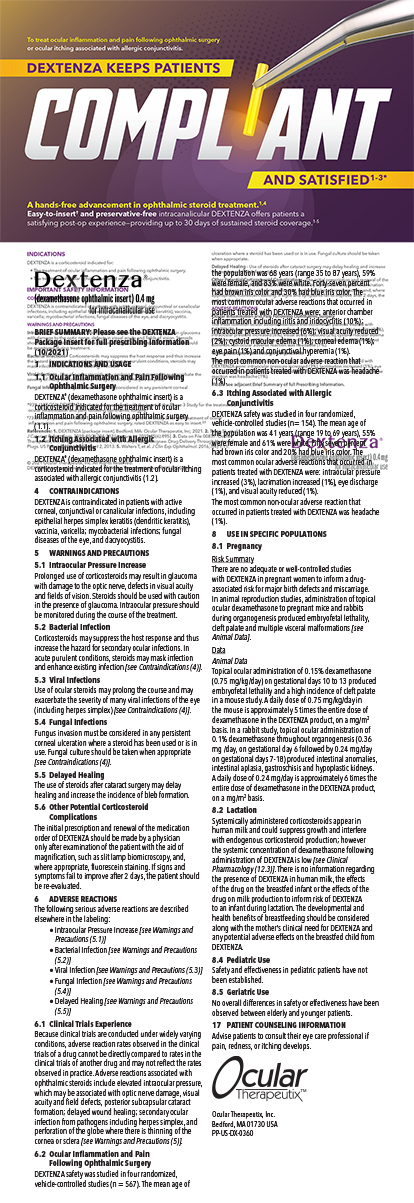

CXL fulfills a large unmet need for our patient population in the Upper Midwest. Every week, we perform the procedure on patients with progressive keratoconus and occasionally with ectasia following refractive surgery. CXL is a useful procedure for patients in ages ranging from newly diagnosed teenagers to older patients whose conditions continue to progress.
The »KXL System (Avedro), along with Photrexa Viscous and Photrexa riboflavin ophthalmic solutions (both by Avedro), is the only CXL system approved by the FDA for commercial use. Since their approval, the number of insurance companies covering the procedure and the photosensitizing agent has steadily grown, with more than 30 insurance carriers now covering CXL.
IN THE NEWS
CMS Issues Preliminary Decision on Unique J Code for Avedro Photrexa Drug Formulations
The CMS has issued a preliminary decision to establish a product-specific Healthcare Common Procedure Coding System (HCPCS) J code for Photrexa drug formulations, according to Avedro. Claims submitted with a product-specific J code are generally processed more efficiently than claims using a miscellaneous code (J3490), which requires manual review.
The preliminary decision by the CMS is expected to be finalized and announced in November 2018, with new or revised codes becoming effective on January 1, 2019.
Unfortunately, the largest commercial carrier in our region, Blue Cross Blue Shield (BCBS) of South Dakota, still lists CXL as investigational, despite the fact that more than 20 other BCBS carriers, including nearby BCBS of Illinois, Kansas, Utah, and Montana, cover FDA-approved CXL.
However, we have slowly made progress with BCBS and other carriers in our market. In May, for example, BCBS of North Dakota published a positive coverage policy for CXL. This progress occurs in two stages: The first is convincing the insurance company to change its listing of CXL from noncovered or investigational to recognizing CXL as a covered service. The second is securing fair reimbursement for that covered service. Despite the challenges, we believe we absolutely have to fight these battles for the well-being of our patients.
CODING FOR CXL
Our practice reached out to a variety of coding experts for recommendations on how to bill for CXL. We decided to bill two separate codes:
- J3490 for reimbursement of the photosensitizing agent, and
- T or Category 3 code (0402T) for the office procedure.
Even with this approach, we have found that carriers sometimes make seemingly arbitrary decisions, such as paying one code in full but denying the second.
Resolving this reimbursement issue requires a commitment from the practice to dedicate staff and physician time. We file claims for our patients and typically go through at least two levels of appeals. Through letters and peer-to-peer review meetings, physicians can play a key role in educating insurance carrier medical directors about CXL and why it is in their best interest to adequately cover and pay for this procedure.
We have gathered peer-reviewed studies and other supporting documents to show evidence that CXL is cost-effective, that it is less costly for the insurance company to pay for CXL than to pay for a corneal transplant, and that our time and costs to perform CXL are justifiable.1,2
It is also important to set expectations regarding costs and coverage with our patients and their families. They must understand before choosing to have the procedure that getting the final insurance coverage determination can be a lengthy process. They must know that the conclusion is uncertain, but that we have tools and programs to help them should the procedure ultimately be determined to be noncovered. (For more on this topic and for further suggestions, see the heading Best Practices for Achieving Success With CXL and read the article Next Steps for CXL, by John D. Sheppard, MD, MMSC.)
For our patients’ sake, we want to be involved in paving the way for wider acceptance of and reimbursement for CXL—one insurance company and one patient at a time. As the progress in coverage rates shows, our efforts are making a difference, helping to turn the tide so that CXL can be accessible to our patients and sustainable for our practices.
Best Practices for Achieving Success With CXL
- Bill correctly. The CMS recently issued a preliminary decision to establish a new J code specific to Photrexa Viscous and Photrexa, which should streamline the claims submission process. If finalized, this new code will become effective in January (see In the News). For now, current billing practice remains unchanged. Seek coding and billing guidance from practice consultants, and consult a recent white paper from the AAO, “How to Bill for Corneal Cross-Linking,” at http://bit.ly/0718Berdahl.
- Consider making use of the Avedro Reimbursement Customer Hub (ARCH) program. ARCH provides assistance with coding, billing, claims submission, appeals if needed, and financial assistance for uninsured patients. Details and other resources are available on Avedro’s website.
- Request a predetermination from the insurance company to determine the coverage policy. If required, file a prior authorization request for the individual patient’s procedure.
- If the patient’s health plan has a negative coverage policy (or no policy in place), have patients sign a Notice of Exclusion From Health Benefits or an Advance Beneficiary Notice. However, encourage patients to file an insurance claim anyway and to reach out to the payers and their employers to explain why this procedure is needed.
- Give your billing staff time to regularly follow up on claims and appeals. This must be done on both the front end and back end.
- Offer low- or no-interest financing options. This can help to make the procedure more affordable for patients who ultimately do have to pay out of pocket.
1. Leung VC, Pechlivanoglou P, Chew HF, et al. Corneal collagen cross-linking in the management of keratoconus in Canada: a cost-effectiveness analysis. Ophthalmology. 2017;124(8):1108-19.
2. Godefrooij DA, Gans R, Imhof SM, et al. Nationwide reduction in the number of corneal transplantations for keratoconus following the implementation of cross-linking. Acta Ophthalmol. 2016;94(5):489-93.




